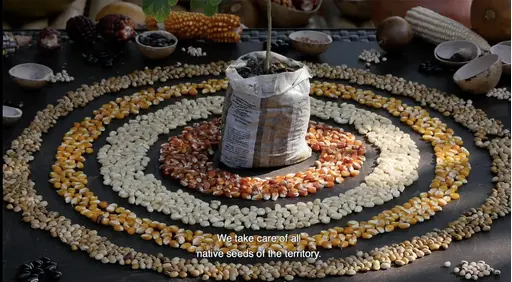
An Interview with Samanta Arango Orozco
Author(s)
Marwa Arsanios, Samanta Arango Orozco
Originally published in Kohl Journal, this interview is between Samanta Arango Orozco, a member of Grupo Semillas, and the artist Marwa Arsanios, who is co-convening with BAK the multi-chaptered project Usufructuaries of earth until 2 June, 2024.
In the interview, Arango shares about Grupo Semillas, an organization that has supported Indigenous and peasant communities for over 20 years, particularly in relation to the protection of native seeds and the strengthening of community-owned forms of production. Arango speaks of Tolima in Colombia which must resist the extractive economic interests of large corporations which seek to utilize its lands, while facing encroaching desertification and navigating the presence of armed guerilla groups emerging from the Colombian conflict. Speaking of how the communities have developed ways to protect and defend a dignified life in the territory in spite of the various forms of violence they face, Arango says how “it’s not simply about staying here, but about staying and living decently.” In the context of Usufructuaries of earth, which calls for a relationship of usufruct with the earth—making “use” of its offers without exhaustion or greed—this interview highlights Indigenous communities’ strategies that “entail ways to inhabit [their] territory without affecting it intensely and in ways that protect it . . .” Through traditional and intergenerational knowledge around the seeds and lands of the region, its people, and particularly, its women, have resisted very powerful groups and social actors—reconnecting, via generous seed-gifting, territories that had previously been separated by conflict.
There are very particular ecosystems in territories such as the south of Tolima. We have a desert next door, which makes the ecosystem especially fragile, meaning that any intervention is felt very strongly. And although it’s true there is a process of natural desertification, it’s also true that external actions have accelerated this process. It is the local communities that are most strongly affected by these drastic changes. This is on top of the whole problem of the struggle for land and against its intensive exploitation by economic projects that see the territory as a form of profit and not as a place inhabited by people and animals and plants. There are many conflicts due to differing economic interests, and this has led the communities currently living here to defend and protect it. Finally, of course, this is a territory that has historically been affected by the Colombian conflict. There has been a constant presence of armed actors—paramilitary and guerrilla groups, as well as militaries and legal armed groups—that have caused a number of very complex situations and overwhelming pain for the local communities. These communities have always been trapped at the crossroads, in the middle of all these interests, including the economic interests of large corporations.
Under these complex circumstances, there is an alternative panorama that gives us hope as an organization, which is the political project that the communities have developed to protect and defend a dignified life in the territory—because it’s not simply about staying here, but about staying and living decently. In this complex situation, full of violence, they have set the goal of continuing to implement their traditional knowledge and their own forms of economy and agriculture. These knowledges and forms of economy are, let’s say, much more integral: you can’t think about the economy and culture as two separate things. On the contrary, these communities’ strategies involve more comprehensive economic models, which themselves entail ways to inhabit the territory without affecting it intensely and in ways that protect it and allow dignified ways of living in it.
Due to the historical conflict, women are the ones who have faced a lot of these problems. When men in their families were killed in the conflict or went to war, women remained, guarding and keeping the territory. They did this in part through the protection of creole and native seeds. The purpose of these seeds is not only to be sown and to produce food for us—it goes much further than this. These seeds can also help to stop the process of desertification; they are the memory of their ancestors, representing the adaptation to drastic changes in the territory. Communities have even developed seeds that have the ability to adapt to the drought. The protection and development of these seeds might be seen as something simple, but it’s revolutionary—especially in this context, where there are conflicts over water and an environmental crisis. So rural women are not only feeding their families, but allowing humanity to have a future in this land. They also represent a long-term achievement in tackling climate change.
Taking care of the seeds requires a lot of courage and strength: although most armed groups don’t see these seed projects as a direct threat, this is only because they don’t understand them—and this is a good thing. Yet the protection of seeds is a form of indirect resistance against these groups, because by protecting the seeds you are protecting the territory. It is a way to say to the community: “We will not leave our territory. Here we have the food, here we have the nourishment, here we can continue living, here’s how to protect the water through the seed process.” So, for me, it’s poetic and very magical to see the power that emanates from these small places that are normally inhabited and defended by women. These initiatives serve as inspiration for rethinking the economic and social dimensions of life more generally, in a way that departs from voracious and destructive economic models. I think that what we can call “home economics” applied in a wider context provides an alternative, comprehensive model for how we can organize economic life. Such economic alternatives tend to be despised because they don’t generate large amounts of money. But they enable sustainability over time, prevent irreversible effects on the environment, and create a more balanced relationship with the territory.
It should also be noted that the issue of saving and protecting the seeds is not isolated but involves an organizational process, because there’s no point in me having seeds if my neighbor doesn’t have seeds. This has led to very strong forms of organization in which people have joined together, exchanged knowledge, and said, “We have to unite.” So it has implications for the social relations in the area, prompting people to begin to recover relations that have been destroyed by violence. For example, we work mostly here in the southern plains of Tolima, Natagaima, and Coyaima, but last year we also started to work with organizations in the mountains, where the majority are peasant organizations (campesinos, although there are also Indigenous communities there). While there is an intense conflict over water here in the southern plains, in the mountains they have a very strong conflict over food sovereignty, because coffee monoculture came in and wiped out everything. Through this whole process, communities of the mountains and the plains have begun to meet again. We’ve seen that, again, women have been the ones who have generated friendly relationships; they’ve started exchanging seeds and taking seeds to the women in the mountains so that communities there, too, can begin these processes of autonomy. We start to see how apparently simple actions have begun to reconnect territories that had been separated by conflict.
Finally, in these initiatives, women have been using their own knowledge to strengthen other women’s processes. The purpose of the seed guardians is not to establish a relationship of ownership or institutionalization—it is not about creating a seed bank. For us, rather, the way to care for and preserve the seeds is by planting and growing them.
These communities concluded that the seeds are better off “walking”—and walking means that they need to be planted and produced rather than stored. If seeds are stored they won’t accomplish their main function, and accumulation practices will emerge. Such accumulation practices are, politically, what is being fought against, because the same accumulation is what has led us to have these problems of land, water, and so on. The accumulation of something results in another group not having it, or not having access to it. So, from a non-accumulation perspective, to be constantly sowing the seeds is the best way to preserve them. The seed, as a common good, should be reproducing itself; it should be immersed in a dynamic where it generates benefits collectively, to all people and not just to certain sectors.
The fish farms are very intensive productive systems that generate soil degradation, the degradation of water sources, as well as the degradation of communities. However, the latter is a very complex and risky issue to discuss, because you don’t even know who the people behind these businesses are. Their identity is not clear, but the power they have is: they demonstrate this through their weapons, through the magnitude of their projects, and through the way they come into the territory without asking—and simply install their business. They hoard water to raise fish that are not even destined for the local market but for export. They come, destroy the waters, the territories, and the communities, and take everything away. All they leave behind is misery, trouble, and deepening inequalities. These fish farms were initially proposed as an economic opportunity, to generate employment. And employment is indeed being generated, but for jobs lacking in decent working conditions which simply exploit people, strip the territories, their resources, and their commons, and deprive communities of their dignity. It makes me nervous to go deeper as these are subjects that are very delicate to talk about. It’s a very sensitive issue.
The banks and the “drop by drop” take advantage of the fact that in many communities oppressed by this economic system, we don’t know how to plan our finances in a way that will allow us a sustainable and dignified life. The economic methodologies people have developed in response to this have allowed them not only to have a broader and more comprehensive perspective on the economy, but also to strengthen organizational processes, allowing people to have autonomy over their money and over what they produce in a sustainable way. This has brought many benefits for communities that have been able to move their productive projects forward, and also for women heads of households who can avoid ending up in huge debt and losing their home. Having economic autonomy gives these women the independence necessary to get out of many violent situations. Women involved in the initiative have the opportunity to participate in the public sphere and to make decisions about the economy, an aspect of society that has been usually dominated by men. These solidarity economy strategies started out as small initiatives like the seed projects, but have been reproducing themselves in a very accelerated way. Today they are having a significant impact on how communities see themselves, and how they plan for a future in which they do not have to depend on these money-lending institutions, both legal and illegal. Because even though banks may be legal, they end up having the same repercussions and effects as the illegal ones, with the aggravating circumstance that the banks are protected by the law.
Related
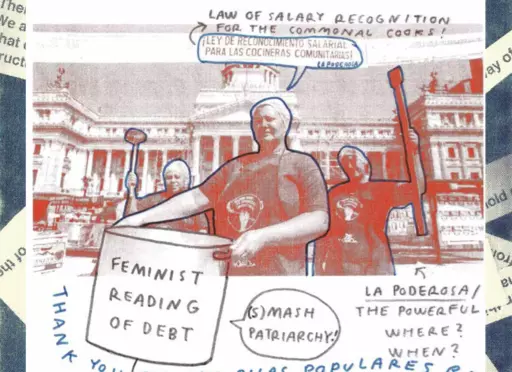
Held in the context of Usufructuaries of earth: chapter two, reading groups and publication, a reading group was convened by Iliada Charalambous and Philippa Driest on 28 April 2024 titled Undoing Debt, at KIOSK, Rotterdam. The reading group looked at debt as a form of gendered and financial violence and sought how to, in turn, “undo debt” through learning shared political tools and vocabulary inspired by transnational feminist movements.
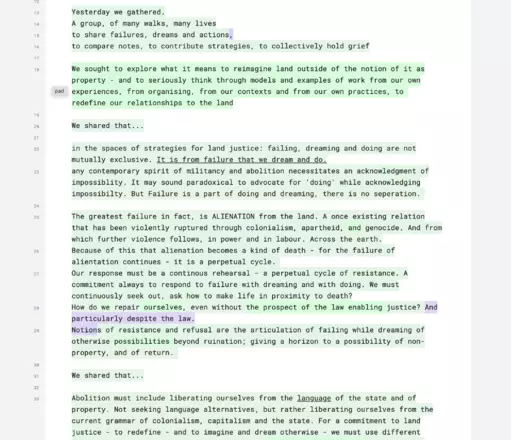
Convened by Johannesburg-based Yvonne Phyllis and MADEYOULOOK (Molemo Moiloa and Nare Mokgotho), the working session Failing, Dreaming, Doing: rehearsing abolition sought to conjure alternate imaginaries of life and labor with earth, beyond the regimes of colonial and racial enclosure. The following text was collectively written by the working session’s participants: Brenna Bhandar, Aya Bseiso, Layal Ftouni, Jennifer Irving, Tareq Khalaf, Gelare Khoshgozara, MADEYOULOOK (Molemo Moiloa and Nare Mokgotho), Marie Nour Hechaime, Yvonne Phyllis, Philip Rizk, Bobby Sayers, Shela Sheikh, and Kasia Wlaszczyk and was read out by Nare Mokgotho as part of “PROPOSITION 3 Failing, Dreaming, Doing: rehearsing abolition” during the Usufructuaries of earth convention public program, Saturday 25 May 2024 at BAK, basis voor actuele kunst, Utrecht.
________________________________________________________________________________
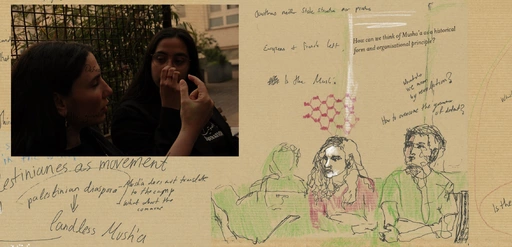
Held in the context of Usufructuaries of earth: Chapter two, reading groups and publication, a reading group spanning two days was convened by Joud Al-Tamimi and Lama El Khatib on 4 and 5 May 2024 titled And in your throats, a sliver of glass, a cactus thorn and On Value-Disrupting Activity, at bookstore خان الجنوب khan Aljanub, Berlin and Hopscotch Reading Room, Berlin respectively. Mokia Laisin put together a collaborative collage of annotations made during both days of the reading group discussions with input from Miriam Gatt on 4 May 2024.
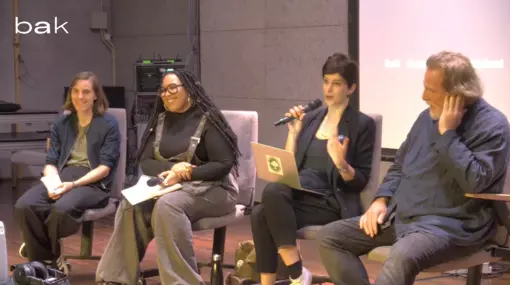
Held as part of day two of Usufructuaries of earth, chapter three, convention, on 25 May 2024, this video documents a closing conversation between Yvonne Phyllis, Denise Ferreira da Silva (online), Verónica Gago, Stefano Harney, Lena Wilderbach, and Brenna Bhandar (online), moderated by Shela Sheikh.
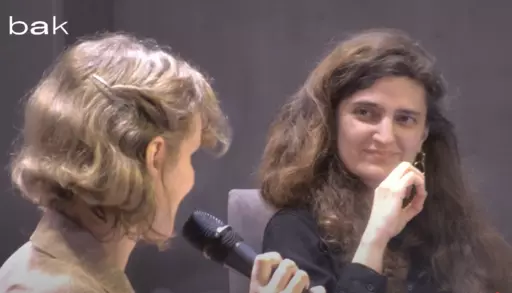
Held as part of day one of Usufructuaries of earth, chapter three, convention, on 24 May 2024, this video documents the words of welcome by Maria Hlavajova, followed by a conversation between Marwa Arsanios and Wietske Maas—as means of introduction to the Usufructuaries of earth public program.
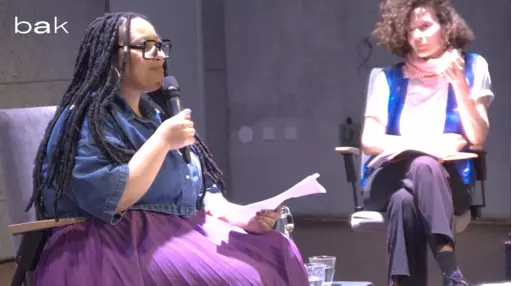
Held as part of day one of Usufructuaries of earth, chapter three, convention, on 24 May 2024, this video documents a conversation between Brenna Bhandar, Yvonne Phyllis, and Ruth Wilson Gilmore(online), moderated by Layal Ftouni.
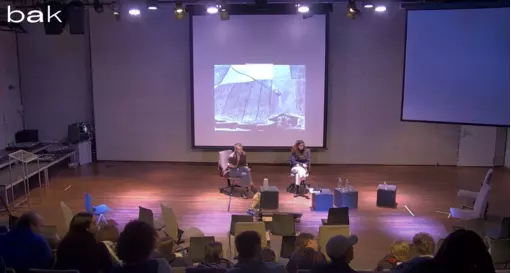
Held as part of day one of Usufructuaries of earth, chapter three, convention, on 24 May 2024, this video documents a conversation between conversation between Philip Rizk and Marwa Arsanios following a screening of Rizk’s film Mapping Lessons (2020).
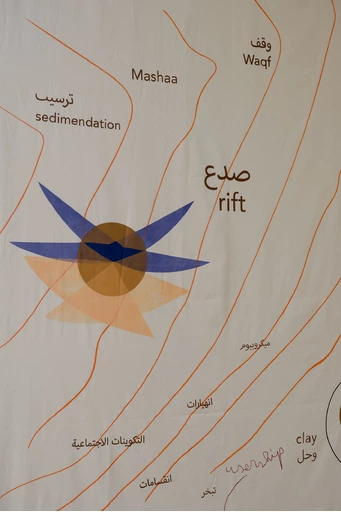
This essay, “Enclosures from Below: The Mushaa’ in Contemporary Palestine,” from geographer and researcher Noura Alkhalili is shared as part of the project Usufructuaries of earth, co-convened by BAK with artist Marwa Arsanios. It is one of the readings for the Amman reading group convened by artist-led research group Bahaleen involving locally-invited artists and researchers.
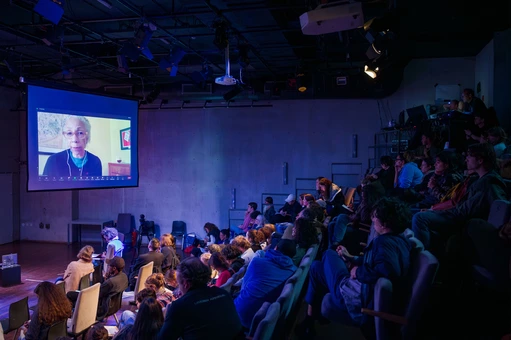
This chapter, “Scholar-Activists in the Mix,” from Ruth Wilson Gilmore's Abolition Geography: Essays Towards Liberation (2022) is shared as part of the project Usufructuaries of earth, co-convened by BAK with artist Marwa Arsanios. It is one of the readings for the Amman reading group convened by artist-led research group Bahaleen involving locally-invited artists and researchers.
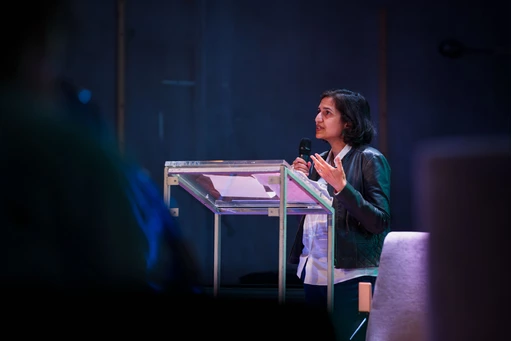
This chapter, “Improvement,” from legal scholar Brenna Bhandar’s Colonial Lives of Property: Law, Land, and Racial Regimes of Ownership (2018) is one of the readings for the Amman reading group.
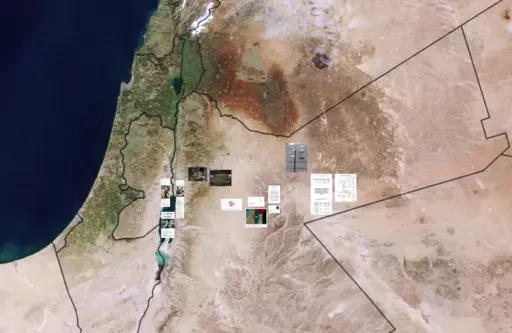
In the context of Usufructuaries of earth: Chapter two, reading groups and publication, a multi-day roaming reading residency, convened by the artist-led research group Bahaleen is held from May 9–13 2024, along the hilltops of Jerash and the edges of Palestine—an hour’s drive from Amman. Invited artists and researchers join Bahaleen in traveling by car and on foot, navigating notions of access and return. Together they grapple with the possibilities of disruption and dissent, aiming to articulate a liberatory vision of the commons from within this geopolitical conjuncture. During the reading residency a board of images and sources were assembled as a harvesting. The images are shared below as screengrabs from this image board, with accompanying links where appropriate.
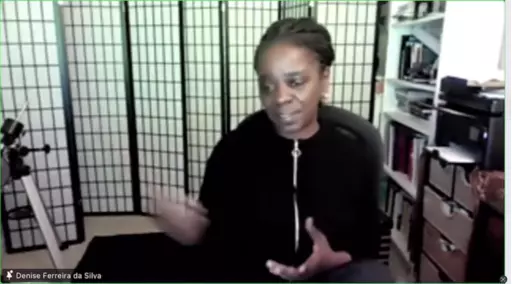
Originally published in Otherwise Worlds: Against Settler Colonialism and Anti-Blackness (Duke University Press, 2020), this essay, "Reading the Dead: A Black Feminist Poethical Reading of Global Capital" by academic, philosopher, and artist Denise Ferreira da Silva is shared here in the context of the project Usufructuaries of earth, co-convened by BAK with artist Marwa Arsanios. This chapter is one of the readings for the Berlin reading group convened by Joud Al-Tamimi and Lama El-Khatib, titled “On Value-Disrupting Activity,” at Hopscotch reading room, 5 May 2024. This reading group explores the political and theoretical stakes of value as it links to violences enacted on and through land and property in Palestine and elsewhere.
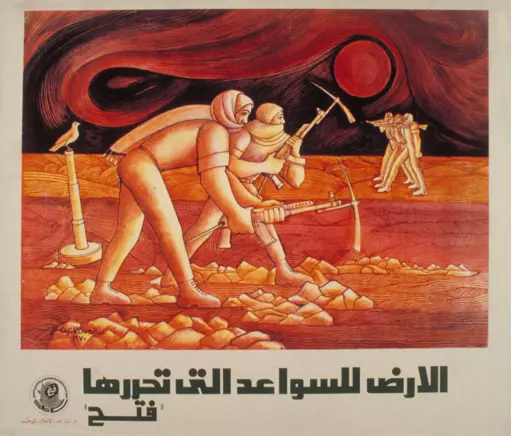
“What is a revolution that neither overthrows a state order nor institutes a lasting one of its own?” This is the question that teacher, author, and political theorist Nasser Abourahme poses in “Revolution after Revolution: The Commune as Line of Flight in Palestinian Anticolonialism.”
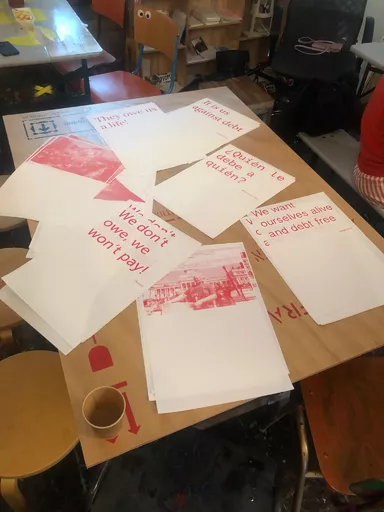
Three excerpts are republished here from researchers and activists Verónica Gago and Lucí Cavallero’s A Feminist Reading of Debt (London: Pluto Press, 2021). The text opens with a simple concept: that contemporary debt cannot be understood by only looking at “public debt,” and must instead look at the indebtedness present in everyday life. The authors call for debt to be adopted by social movements as a key issue, and furthermore, for people to be cognizant of the links between debt and sexist violence.
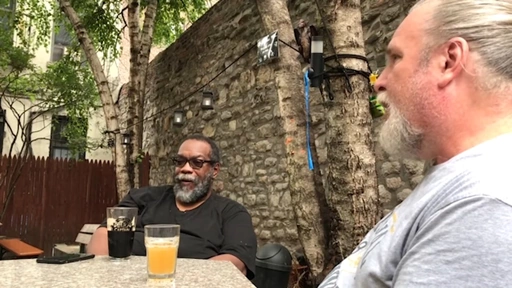
This is an extract from the chapter “Debt and Study,” in Stefano Harney and Fred Moten’s The Undercommons: Fugitive Planning & Black Study (2013). Across its three sections—Debt and Credit, Debt and Forgetting, and Debt and Refuge—this extract traces the sites and practices of “desired” and undesired debt that perforate contemporary financial capitalism and western culture. The text moves through different people who are marked as debt carriers, such as the precariat, the student, and racialized people, among others.
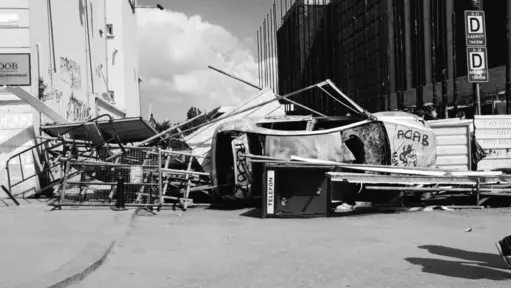
“Riot Now: Square, Street, Commune” is a chapter from political theorist Joshua Clover’s Riot. Strike. Riot: The New Era of Uprisings (Verso, 2016). Taking the classical Greek agora—a place of assembly and commerce—as a starting point, Clover suggests that it is perhaps no coincidence that many of the riots and occupations that emerged in recent decades either happened or began in modern squares. He speaks of how this emergence of rioters corresponded to “an underlying political-economic unity, a material reorganization of society, which provide[d] them a shared set of problems and a shared arena in which to confront them.”
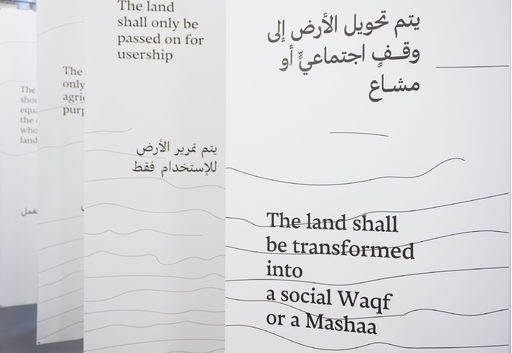
Charting the interconnectedness of capitalism, colonialism, and nationalism, Peter Linebaugh’s “Palestine & the Commons: Or, Marx & the Musha’a” speaks of “the violence of mapping, titling, buying, and selling which cast people into cities and camps following their expropriation from the land.”

Originally published in Kohl Journal, this interview is between Samanta Arango Orozco, a member of Grupo Semillas, and the artist Marwa Arsanios, who is co-convening with BAK the multi-chaptered project Usufructuaries of earth until 2 June, 2024.
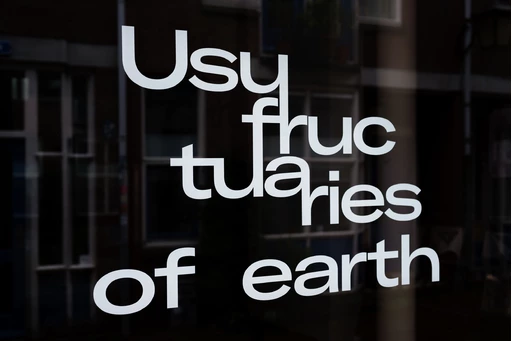
A slow-growing table of contents for the Usufructuaries of earth online reader. The reader emerges, to begin with, as a constellation of archival texts assembled here through the “Usufructuaries of earth” focus on Prospections. Throughout the duration of Usufructuaries of earth project and beyond, diverse content—long reads, interviews, conversations, and visual interventions—will incrementally be (re)published into a public research and learning curriculum that studies histories and propositions of usufruct, of renewing shared practices of usership of and with earth.
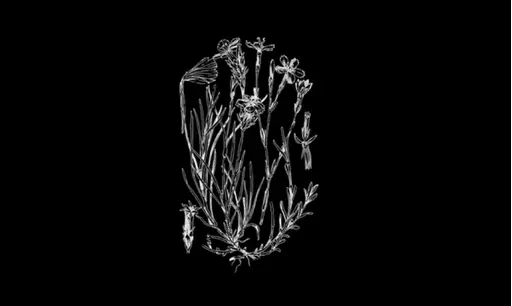
“We are in the siege of a nature that has been hurt, divided, defiled, poisoned, harmed, and made to bleed,” writes Pelşîn Tolhildan, member of the Kurdish Women’s Movement.

Usufructuaries of earth is the first comprehensive exhibition of Marwa Arsanios’s work in the Netherlands. The exhibition foregrounds the artist’s collaborative approach to bringing together ecological, feminist, and decolonial knowledges and practices that put forward ideologies of usufruct, unhinging property-relations from the idiom of individuated possession and toward forms of common, more-than-human userships. Here is an audio tour of the exhibition given by BAK convenor of research and publications Wietske Maas.